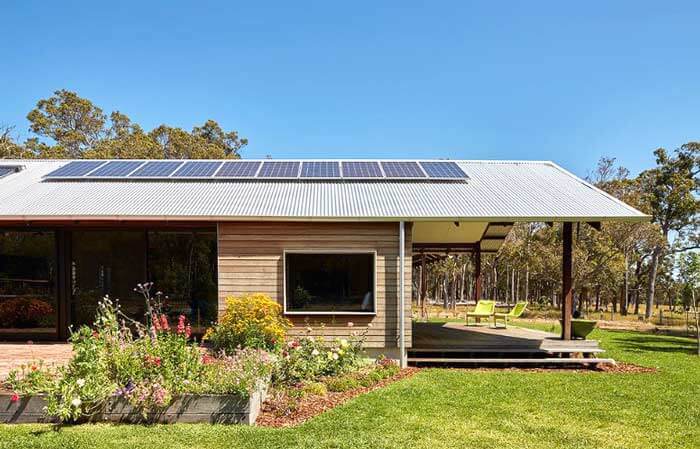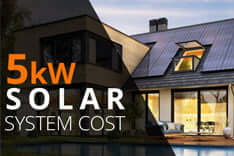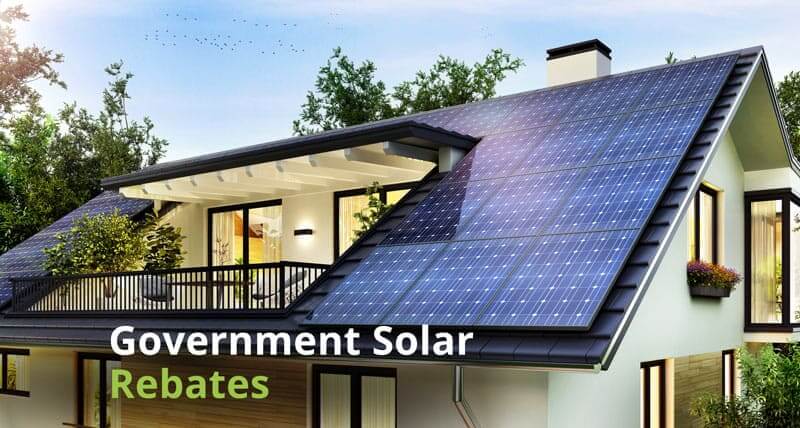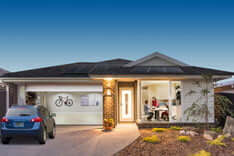Home What Size Solar System do I Need?
What Size Solar System do I Need?
After deciding to transition to solar energy for your home, the following move is to determine the perfect solar system size that suits your residence.
Generally, the size of the solar system you need depends on your home’s energy consumption rate. The more energy you spend per day, the bigger the solar system you’ll need.
Your final decision will also depend on what you hope to achieve with solar power. Do you want to save money? Reduce your carbon footprint? Maximize your ROI?
Table of Contents
ToggleHow to calculate the number of solar panels needed

The easiest way to find out how many solar panels you’ll need is by consulting a solar installer in your area.
But if you don’t have the time, you can also make a rough calculation. One of the easiest ways to do this is by dividing your solar system’s size by your solar panels’ wattage. i.e.,
No. of panels = Size of the system (W)
Output of panel(W)
For instance, if you’ve installed the most popular, 5kW solar system, and you intend to use 275W solar panels, you’ll need: 5,000/275 = 18 solar panels.
However, you’ll also need to factor in the amount of sunlight you receive in your area and the amount of roof space available to you.
If you live in a state that receives low sunlight intensities, you’ll need numerous low-wattage solar panels to meet your household’s daily energy requirement.
Similarly, if you have a small roof space, you’ll need fewer high-wattage solar panels to meet your energy demands. Keep in mind; more panels don’t always mean more output; it all comes down to the wattage of each panel.
Solar system chart
Most solar panels used in residential installations come in the standard 1.7m x 1m size, which is around 1.7 square meters each. The output of these panels ranges from 250W to 350W.
The 1.6m x 1m solar panels are also quite common, especially for 72-cell panels.
However, the advancement in solar technologies, especially in commercial solar, has given rise to bigger solar panels. Today, it’s common to spot 2m x 1.5m solar panels on rooftops, which gives around 3.0 square meters.
Homeowners are opting to go for bigger size solar panels because they offer slightly more watts per m2. Bigger solar panels are also much quicker to install and require fewer panels.
How much roof space will I need?
The amount of roof space you’ll need will mainly depend on the number and size of solar panels you choose to install.
Assuming you go with the standard 1.7m x 1m solar panels, each panel will occupy 1.7 m2. For 18 solar panels required on a 5kW solar system, this would cost you around 30.6m2.
But this isn’t the only factor you should consider when calculating your roof space. Other factors that could affect the available roof space include:
- Orientation of your roof – North-facing solar panels are usually the most efficient in Australia. If all your panels can’t face the same direction, you’ll need more space as you split other panels to face the East-west direction. Doing this will mean that you’ll need to allocate space for multiple inverters.
- Shape of your roof – Rectangular and trapezoidal-shaped roofs tend to waste a lot of space since most the rectangular solar panels won’t cover all edges.
- Setback rules – During installation, the international fire setback rules require the panels to be set fewer inches from the edge of the roof. This will eat up some extra space.
- Equipment on your roof – The equipment you have mounted on your roof could also be using up a lot of space which could be used for your panels. You may be able to move things like water heaters, and satellite dishes, but your vents, and pipes will be a problem.
Factoring all these in your calculation should give you a more accurate estimate of how much roof space you’ll need. If possible, get your solar installer to do the assessment for you to ensure you don’t miss any detail.
What's the most popular solar system size?
The 5kW solar system. This system is a particular favorite among most Australian residential homes because it generates enough power to run a family at a great price.
It also offers a fairly quick ROI of between 3-4 years, and it requires few solar panels. This makes it very convenient for homes, even those with small roof spaces.
The government rebates on the 5kW solar system also make it affordable for homeowners. This system costs anywhere from $4,500 to $7,000.
6.6kW solar systems are also really popular among most homes in the country.
For commercial solar, the 30kW solar system has been the most popular. It generates a lot of energy and is an affordable option for most SMEs.
How many solar panels for a 5kW solar system?
Between 15 and 20 solar panels. It all depends on the power capacity of the solar panels you use during the installation. Most owners opt for the solar panels with outputs ranging from 250W and 330W.
If you use 250W solar panels, you’ll need around 20 panels for the 5kW solar system. But if you use 330w solar panels, you’ll only need 20 panels.
The trick to choosing panels for a 5kW solar system lies in your available roof space. If you don’t have a large space, go for the more expensive but efficient 330 – 350W panels.
But if space isn’t an issue, you can opt for the lower-priced, less efficient solar panels.
How many Solar panels do I need to power my home?
Approximately 20 – 28 solar panels. It will depend on the size and energy requirements of your home. Homes can be subdivided into small, medium, and large.
The more people reside in your home, the more energy you’re likely to consume daily. Therefore, bigger homes need more solar panels than smaller homes. For instance, a 5kW solar system, which is a medium system serving 4 – 5 people, requires more panels than a 3kW solar system serving 2 – 3 people.
The table below shows how many panels you’ll need for your home depending on the size.
| Suits home size | System size | No. of panels | No. of People |
|---|---|---|---|
| Small | 1.5KW | 6 | 1 – 2 |
| Small – Med | 2KW | 8 | 2 – 3 |
| Medium | 3KW | 12 | 3 – 4 |
| Med – Large | 4KW | 16 | 4 – 5 |
| Large | 5KW | 20 | 5 – 6 |
| X Large | 6KW | 24 | 6 – 7 |
| XX-Large | 7KW | 28 | 7 – 9 |
| Space Ship | 8KW | 32 | 9 – 12 |
How many solar panels do I need to run home utilities?
The average Australian home would require 6 – 14 solar panels to run the home utilities efficiently. This could include the refrigerator, the Air Conditioning unit, and Central air conditioning as well as the heated swimming pool.
A regular fridge rated 250W, running for 4 hours a day will consume about 1kW in a day. Assuming you have 300w solar panels, you’ll only need around 3 panels to run it.
Other devices like the AC would need about 2 – 4 solar panels while bigger consumers like a swimming pool, an outdoor bathtub, and maybe an electric vehicle may double your panel requirements to between 8 – 12 panels.
Keep in mind; these numbers are all subject to change depending on your location and solar system size.
Knowing the number of panels each home appliance will require makes it so much easier to determine the number of panels you’ll need for your home.
Should I OVERSIZE my solar system to save even more?
This is a common practice. Basically, with the RIGHT size system and feed-in tariffs, you can save up to 90% of your total power costs.
If you get a system 20% larger than your home needs, you can eliminate 100% of your bills as the system sells more to the utility company than you need to use.
You’ll also receive a much larger rebate amount for a bigger solar system than you would for a small solar system. Oversizing your solar system will also streamline your path to getting a solar battery.
With your solar system generating a lot more electricity, an oversized system will produce more than enough power to run your home and also send the excess to the solar batteries.
For all these benefits, you should definitely oversize your solar system.
Limiting factors to solar system size
One of the biggest factors that may limit you from getting the solar system size you need is money. Although the cost of solar panels is falling through the years, solar systems are still fairly expensive.
The incentives and rebates from the government have also come to help cut down these costs, but the price still remains a limiting factor for the average Australian homeowner.
At the end of the day, you’ll have to settle for the solar system that’s within your budget. Not necessarily the one that’s right for you.
Another crucial factor is the roof space available. During installation, not every homeowner has the luxury of a large roof space. Homeowners with small roof spaces are limited to fewer solar panels that don’t meet the energy demands they need.
Moreover, the only option, high-efficiency solar panels, are too expensive for the homeowners.
Finally, the orientation of the solar panels can also be the limiting factor for most Australians. In the Southern Hemisphere (including Australia), solar panels facing North tend to have some of the best outputs in the market.
If all your panels can’t fit on your roof facing North, this will limit how much power you can generate daily. Solar panels facing the East-West direction usually have around 10% lower efficiency. However, this could work if you use most of your energy in the mornings and early evenings.
Selecting your system size step by step
Once you have factored in all the limitations and constraints you’ll face when installing solar; it may be time to size your grid-tied solar system.
There are six steps you can follow to come up with the perfect solar system for your home. Here’s how to go about it.
1. Current usage
Your first step to the right size for a solar system is getting to understand your current power usage. Get all your energy bills from your previous years and divide them by 12 and 365, to find out your monthly and average daily usage.
Take note of the power bill during summer and winter as well. Consumption tends to be higher during summer and lower in winter.
2. Sun exposure
The amount of sunshine solar panels receives directly affects how much power a system can generate. The sun intensities will vary depending on the city you’re in. So, find out how much sunlight your area receives through the sun-hours chart.
3. Roof space
The roof space available for homeowners also determines the size of solar panels you can mount on your roof. The more panels you can have, the more output you can tap from your solar system.
For small roof spaces, consider getting a few high-efficiency solar panels. These panels may be more expensive, but they are a better investment long-term.
If you have a large roof space, you can opt for large solar panel sizes as they offer better watts per m2.
4. Calculate output
Once you have figured out the best angle and orientation of your solar panels, and you know how much roof space you can have, it’s time to calculate the amount of power you can receive from your solar system.
You can use a solar system calculator to help you get more accurate output estimation.
5. Grid-tied or battery backup
Your last step should be deciding whether you’ll connect your solar system to the grid, or you’ll opt for a battery backup. If your utility company offers net metering, ensure that the solar system you choose qualifies for its grid-tied solar programs.
However, if you want to live completely off-grid and eliminate almost all your energy bills, ensure that your solar system can generate enough power to store in your battery.
If you still have trouble selecting a solar system size, be sure to consult with an expert to guide you through these steps.
FAQs
Yes! Although running a house seemed impossible a few years back, advancement in solar technology now allows you to run an entire house with solar power. All you need is a highly efficient solar panel, good inverters, and reliable solar batteries.
Table of Contents
Toggle




